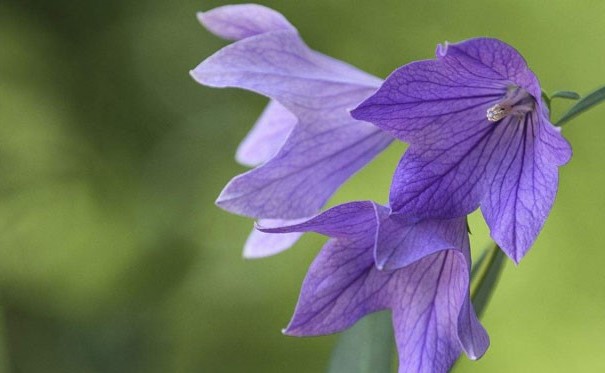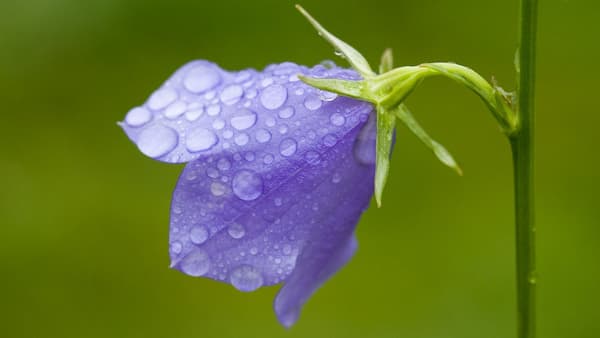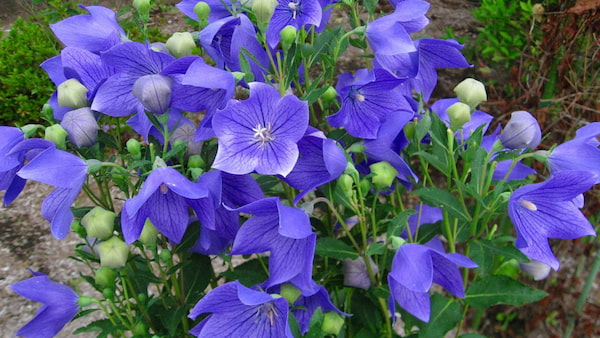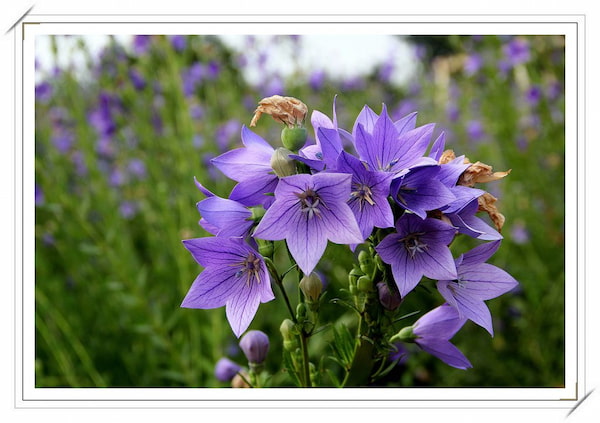Balloon Flower Profile
Written by Iris
Oct 28 2021

Balloon flower (Platycodon Grandiflorus) is a clump-forming perennial flower, a member of the easy-to-grow bellflower family of plants. They are so named because puffy, balloon-like buds swell up to produce the 2- to 3-inch star-shaped flowers. Blooming all summer long, it is an excellent plant for border gardens or rock gardens, and it freely self-seeds in the garden. The species plant has intense blue-violet flowers, but there are also cultivars with white and pink blooms. Balloon flower is generally planted in the spring after the danger of frost has passed. It grows quickly to bloom in its first year.

It’s also used for medicinal purposes in both China and Korea. In traditional Chinese medicine, the plant is used for treating the common cold, cough, and associated symptoms. In Korea, the roots of platycodon grandiflorum are used for treating several diseases as they are believed to have powerful anti-inflammatory and anticancer properties. Balloon flower root is believed to help treat insulin resistance in the body.

Read Next:
Top 10 Most Beautiful Roses in the World
Top 10 Most Beautiful Flowers in the World
26 Best Autumn Flowers to Plant for Fall Color in Garden
Balloon Flower PictureBalloon Flower InfoBalloon Flower Native HabitsHow to Grow and Care for Balloon FlowerBalloon Flower LightingBalloon Flower Soil CareBalloon Flower WateringBalloon Flower Temperature & Humidity CareBalloon Flower FertilizerBalloon flower UsesVarieties of Balloon FlowerAstra seriesFuji seriesKomachiSentimental BlueBalloon Flower Common Pests/Diseases
Balloon Flower Picture

Balloon Flower Info
| Botanical Name | Platycodon grandiflorus |
| Common Name | Balloon flower, Chinese bellflower, Japanese bellflower |
| Plant Type | Herbaceous perennial |
| Mature Size | 1– 2 1/2 feet tall, 1–1 1/2 feet wide |
| Sun Exposure | Full sun to part shade |
| Soil Type | Rich, loamy, medium moisture, well-draining |
| Soil pH | 5.5–7.5 (acidic to slightly alkaline) |
| Bloom Time | Summer |
Balloon Flower Native Habits
The plant has a clump-forming growth with alternate bright green leaves that form along the tall stems. Balloon flower will grow to about 1 – 2 1/2 ft. tall, by about a foot. to 18 inches wide. Dwarf varieties won’t grow much taller than 1 foot high.How to Grow and Care for Balloon Flower
Overall, balloon flowers are fairly low-maintenance plants and are quite pest- and disease-resistant. You can start with nursery plants or grow your balloon flowers from seed. Planted in the early spring after the threat of frost has passed, balloon flowers should bloom during their first season. However, you also can plant them later in the growing season (spring to fall), though you might not get blooms until their second year.Balloon Flower Lighting
You will get the most flowers if you plant balloon flowers in full sun (at least six hours of sunlight on most days). However, they will be fine in part shade and might actually prefer some shade from where the afternoon sun is especially hot.Balloon Flower Soil Care
Balloon flowers prefer organically rich, loamy soil that has good drainage. They don’t grow well in dense soil, such as clay. They like a soil pH in the 5.5 to 7.5 range.Balloon Flower Watering
Keep the soil of young plants consistently moist but not soggy. Once established, balloon flowers like a moderate amount of moisture in the soil, but they can tolerate short periods of drought. They won’t need a lot of supplemental watering unless you have a long period without rainfall that causes the soil to dry out.Balloon Flower Temperature & Humidity Care
Balloon flowers are hardy and do well in USDA growing zones 3 to 8. Their ideal temperature range is between 60 and 80 degrees Fahrenheit, but they can withstand higher temperatures if they have some shade in the afternoon. Frost can kill young plants and will cause established plants to die back into the ground in the fall. Balloon flowers tolerate both humid and dry air conditions, provided they have the right amount of soil moisture.Balloon Flower Fertilizer
Balloon flowers typically don't need supplemental feeding if you have rich soil. But a layer of compost in the fall can help them replenish the energy they expend blooming during the growing season. If you have poor soil, use an all-purpose, slow-release fertilizer in early spring.Balloon flower Uses
The balloon flower plant is grown for ornamental purposes in most areas. However, in Korea, it is primarily grown for consumption. The plant, along with its roots, is widely consumed in Korea in various ways because it’s believed to offer a variety of health benefits.It’s also used for medicinal purposes in both China and Korea. In traditional Chinese medicine, the plant is used for treating the common cold, cough, and associated symptoms. In Korea, the roots of platycodon grandiflorum are used for treating several diseases as they are believed to have powerful anti-inflammatory and anticancer properties. Balloon flower root is believed to help treat insulin resistance in the body.

Varieties of Balloon Flower
There are several good varieties of balloon flowers, including:Astra series
These have double flowers with 10 petals in blue, pink, or white. They're a good choice to start from seed.Fuji series
These are the most commonly sold varieties, as well as the tallest, with 30-inch stems and flowers in blue, pink, or white.Komachi
The purple-blue flowers in this variety remain in their puffy pillow stage.Sentimental Blue
This dwarf variety grows about 6 inches tall with lots of 1- to 2-inch purple flowers.
Balloon Flower Common Pests/Diseases
Apart from the possibility of developing root rot, when the soil consistently remains too wet, the plant isn’t susceptible to any major disease. This long lived perennial is deer resistant. Slugs and snails may prove to be a problem for your balloon plant, especially in moist conditions. To deter these pests, try setting out a bowl of cheap beer. The gastropods will be attracted to the fermented beverage, causing them to fall in and drown. Also, if soil drainage is inadequate, your plant may develop root rot. Excessive moisture can also damage the foliage; be sure to prune leaves when necessary to increase air circulation throughout the plant.Read Next:
Top 10 Most Beautiful Roses in the World
Top 10 Most Beautiful Flowers in the World
26 Best Autumn Flowers to Plant for Fall Color in Garden
Latest Updated
- Benefits of Bugleweed - 7 Science-backed Health Benefits
- Bugleweed Dangers & Side Effects - Is It Poisonous?
- How to Plant Evergreen Trees - What You Should Know
- When to Plant Evergreens - Grow Guide for Evergreen Trees
- 12 Wonderful Evergreen Shrubs for Your Garden
- 12 Popular Evergreen Plants with Pictures for Beginners
- When And How To Prune A Lilac Bush Like a Pro
- How to Grow & Care for Lilac Vine (Hardenbergia Violacea)
- Japanese Lilac Tree (Syringa Reticulata) Care & Propagation Guide
- Shumard Oak Pros and Cons - What to Know
Popular Articles
- Winter maintenance of Antirrhinum Majus
- How to Grow Terminalia Mantaly Tree
- How to Grow and Care for Crossostephium Chinense
- How to grow Antirrhinum Majus in spring
- Peristeria Elata (Dove Orchid) Profile: Info & Care Guide
- Underwatered Snake Plant (Sansevieria Trifasciata) - Signs And How To Fix
- How to Care for Brazilian Jasmine Plant (Mandevilla Sanderi)
- How to Grow & Care for Graptopetalum Purple Delight in Summer
- Rosa Chinensis (China Rose): Plant Growing & Care Tips
- How to Care for Baby Sun Rose (Aptenia Cordifolia)